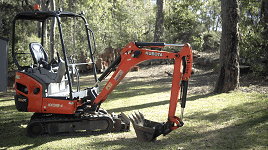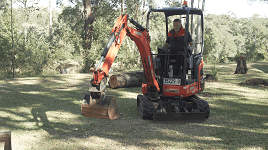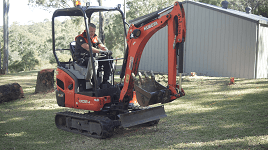How to Use an Excavator
How-To
Excavators are easy to use, and the smaller ones are ideal for tight access areas and small to medium projects such as drainage, trenches, pool excavations and building footings.
You don’t need a special licence to hire and operate an excavator, which means they are available to everyone from DIY enthusiasts, to tradies and contractors looking to lay in a trench or finish off a retaining wall.
Let's take a look at the basics of excavator operation, including safety, how to steer, and some of the jargon you might hear when the conversation turns to digging.
If you have any questions about our equipment or need advice on the best equipment to use, the team at your local Kennards Hire branch will be able to help you.
Steps
Step 1 - Preparing for the dig
Before you begin digging, it’s a good idea to call Dial Before You Dig on 1100 or visit the website www.1100.com.au, or BeforeUDig in New Zealand on 0800 248 344 or at www.beforeudig.co.nz. This is a free, national service that connects members of the public and tradies to owners of underground assets, such as water authorities, councils and electricity companies.
These organisations then supply you with information they have about the infrastructure in the location. However, this information is not always 100% accurate. To be certain about pipes or cables in your excavation area, you can hire a pipe locator or a ground penetrating radar, which will show you exactly what’s happening underground.
When you pile up the spoil, remember that you will also need to remove it later – and excavators are diggers, not movers! You could hire a dumper or a mini loader and a skip. Talk to your Kennards Hire rep about the best removal method for your project.

Step 2 - Operator of a typical excavator
Although Kennards Hire staff will be able to show you how the excavator works, always consult the operator manual for specific instructions and safety tips.
When you get in or out of the cab, always have three points of contact on the machine: gripping the machine with two hands, as you step up or down.
Once inside, fasten your seatbelt, then push down the lock lever when you are ready to move. The machine will not operate unless this safety feature is released.
Two travel sticks control the forward and backward movement of each excavator track independently. Pushing the left one forward starts the left track and the machine starts turning to the right – and vice versa. If you want to go straight, push both sticks forward at once.

Step 3 - Moving the boom and the bucket
Two additional levers control the boom. If you pull back on the right lever, the boom raises. Pull back on the left lever and the boom moves towards you.
The bucket is attached to the end of the boom. To curl the bucket, move the right-hand lever to the right. To uncurl it, move it to the left.
To rotate the cab, boom and bucket, push the left boom lever to the side. This is known as slewing. When you do so, make sure as you turn that you are not going to hit anything with the bucket. Accidents happen when someone is trapped against a wall or fence by the bucket or boom.

Step 4 - Digging
Have the bucket in the open position when it goes into the ground, then curl it to trap the earth for removal. The teeth of the bucket should enter the ground vertically, using the force of the boom. As you move the boom towards you, curl the bucket so that the spoil is scooped up.
These tips should give you some idea of what’s involved in operating an excavator. Like anything, it takes planning, common sense and a bit of patience. But soon you will be digging like a champion!
Keep in mind that this is a guide only and that more detailed information is available from your Kennards Hire staff and the excavator’s operator manual.
Don’t hesitate to ask for advice from your Kennards Hire team on any aspect of your excavation project.

